Virtual Reality in Historic Urban District Renovation for Enhancing Social and Environmental Sustainability: A Case of Tangzixiang in Anhui
Abstract
1. Introduction
2. Theoretical Basis
2.1. Sustainable Urban District Renovation
2.2. VR in Urban District Renovation
2.3. Research Gap and Target
3. Case Study
3.1. Facts of the Case of Tangzixiang
3.2. Description of the Renovation Solutions
4. Methodology
4.1. Construction of VR Scene
4.2. Survey and Questionnaire
4.3. Environmental Benefits from Paper Saving in China
5. Results
5.1. Basic Information about the Participants
5.2. Time to Complete the Task
5.3. VR Experience
5.4. Engagement of Inhabitants
5.5. Preservation of Local Culture
5.6. Feedback
5.7. Environmental Benefits from Paper Saving in China
6. Discussion and Conclusions
- (1)
- The effectiveness of the VR technology in the bottom-up decision-making process is proven to offer inhabitants opportunities to participate and promote both process and result democracy. An average score of 5.0 (out of 5.0) was given in the question “VR increases my engagement in renovation”, indicating VR is able to improve the engagement of the inhabitants. Scheme 1, in a traditional architectural style, is more effective in avoiding the loss of the sense of place and preserving local culture. Public space was found as a key point to consider in the renovation plan, ranging from mobilizing community interaction to uniting society and forming cohesion, while even affecting daily political life. The scheme was then improved by the design studio after the survey based on the questionnaire results and comments.
- (2)
- The average time required to complete the VR operation and questionnaire was found to be 13.3 min. As the age of participants increased, the time required to complete the task decreased. Conversely, an increase in educational level resulted in an increase in the time required to complete the task. The age-related and education-related differences in completion time is the level of interest or engagement with VR technology and the information presented in the questionnaire.
- (3)
- Smooth movement mode is preferred by participants. VR sickness is a challenge for the aged participants. Moreover, the VR quality is sufficient for effective scheme evaluation. VR technology is well-received by residents and holds promise for improving the evaluation of proposed renovation schemes.
- (4)
- Using VR as a substitution of paper document for scheme review can achieve a reduction of 5.91 × 106 kg NOx eq of ozone formation, 8.28 × 106 kg PM2.5 eq of fine particulate matter formation, and 9.77 × 106 kg SO2 eq of terrestrial acidification per year in China.
Supplementary Materials
Author Contributions
Funding
Institutional Review Board Statement
Informed Consent Statement
Data Availability Statement
Conflicts of Interest
References
- Shanti, Z.; Al-Tarazi, D. Virtual Reality Technology in Architectural Theory Learning: An Experiment on the Module of History of Architecture. Sustainability 2023, 15, 16394. [Google Scholar] [CrossRef]
- Yung, E.H.K.; Chan, E.H.W.; Xu, Y. Sustainable Development and the Rehabilitation of a Historic Urban District–Social Sustainability in the Case of Tianzifang in Shanghai. Sustain. Dev. 2014, 22, 95–112. [Google Scholar] [CrossRef]
- Zhou, R.; Guo, Y.; Wu, Y. Exploration on the Innovation Model of County Urbanization Development with the Resource Constraints in China. Sustainability 2023, 15, 16129. [Google Scholar] [CrossRef]
- Frezza, M.; White, K.E. Promoting Sustainable Workplace Routines: The Identity and Practice Interdependence Model. Sustainability 2024, 16, 993. [Google Scholar] [CrossRef]
- Maněnová, M.; Wolf, J.; Skutil, M.; Vítová, J. Communication and Interaction Practices in Czech Classrooms with a Teaching Assistant. Sustainability 2024, 16, 989. [Google Scholar] [CrossRef]
- Han, J.; Lee, S. Verification of Immersive Virtual Reality as a Streetscape Evaluation Method in Urban Residential Areas. Land 2023, 12, 345. [Google Scholar] [CrossRef]
- Serra, J.; Iñarra, S.; Torres, A.; Llopis, J. Analysis of Facade Solutions as an Alternative to Demolition for Architectures with Visual Impact in Historical Urban Scenes. J. Cult. Herit. 2021, 52, 84–92. [Google Scholar] [CrossRef]
- Bolanča Mirković, I.; Bolanča, Z. Storage of Documents as a Function of Sustainability. Sustainability 2023, 15, 3964. [Google Scholar] [CrossRef]
- Oliveira, J.; Azevedo, A.; Ferreira, J.J.; Gomes, S.; Lopes, J.M. An Insight on B2B Firms in the Age of Digitalization and Paperless Processes. Sustainability 2021, 13, 11565. [Google Scholar] [CrossRef]
- Köck, B.; Friedl, A.; Serna Loaiza, S.; Wukovits, W.; Mihalyi-Schneider, B. Automation of Life Cycle Assessment—A Critical Review of Developments in the Field of Life Cycle Inventory Analysis. Sustainability 2023, 15, 5531. [Google Scholar] [CrossRef]
- Chan, E.; Lee, G.K. Critical Factors for Improving Social Sustainability of Urban Renewal Projects. Soc. Indic. Res. 2008, 85, 243–256. [Google Scholar] [CrossRef]
- Cuthill, M. Strengthening the ‘Social’in Sustainable Development: Developing a Conceptual Framework for Social Sustainability in a Rapid Urban Growth Region in Australia. Sustain. Dev. 2010, 18, 362–373. [Google Scholar] [CrossRef]
- Wang, X.; Aoki, N. Paradox between Neoliberal Urban Redevelopment, Heritage Conservation, and Community Needs: Case Study of a Historic Neighbourhood in Tianjin, China. Cities 2019, 85, 156–169. [Google Scholar] [CrossRef]
- Zhang, Q.; Yung, E.H.K.; Chan, E.H.W. Comparison of Perceived Sustainability among Different Neighbourhoods in Transitional China: The Case of Chengdu. Habitat Int. 2020, 103, 102204. [Google Scholar] [CrossRef] [PubMed]
- Lin, S.-H.; Huang, X.; Fu, G.; Chen, J.-T.; Zhao, X.; Li, J.-H.; Tzeng, G.-H. Evaluating the Sustainability of Urban Renewal Projects Based on a Model of Hybrid Multiple-Attribute Decision-Making. Land Use Policy 2021, 108, 105570. [Google Scholar] [CrossRef]
- Li, X.; Zhang, F.; Hui, E.C.; Lang, W. Collaborative Workshop and Community Participation: A New Approach to Urban Regeneration in China. Cities 2020, 102, 102743. [Google Scholar] [CrossRef]
- Yung, E.H.; Chan, E.H.; Xu, Y. Community-Initiated Adaptive Reuse of Historic Buildings and Sustainable Development in the Inner City of Shanghai. J. Urban Plan. Dev. 2014, 140, 05014003. [Google Scholar] [CrossRef]
- Yung, E.H.K.; Zhang, Q.; Chan, E.H. Underlying Social Factors for Evaluating Heritage Conservation in Urban Renewal Districts. Habitat Int. 2017, 66, 135–148. [Google Scholar] [CrossRef]
- Caprotti, F.; Gong, Z. Social Sustainability and Residents’ Experiences in a New Chinese Eco-City. Habitat Int. 2017, 61, 45–54. [Google Scholar] [CrossRef]
- Zhang, Q.; Yung, E.H.K.; Chan, E.H.W. Towards Sustainable Neighborhoods: Challenges and Opportunities for Neighborhood Planning in Transitional Urban China. Sustainability 2018, 10, 406. [Google Scholar] [CrossRef]
- Langston, C.; Yung, E.H.-K.; Chan, E.H.-W. The Application of ARP Modelling to Adaptive Reuse Projects in Hong Kong. Habitat Int. 2013, 40, 233–243. [Google Scholar] [CrossRef]
- Al-Kodmany, K. Using Visualization Techniques for Enhancing Public Participation in Planning and Design: Process, Implementation, and Evaluation. Landsc. Urban Plan. 1999, 45, 37–45. [Google Scholar] [CrossRef]
- Stauskis, G. Development of Methods and Practices of Virtual Reality as a Tool for Participatory Urban Planning: A Case Study of Vilnius City as an Example for Improving Environmental, Social and Energy Sustainability. Energy Sustain. Soc. 2014, 4, 7. [Google Scholar] [CrossRef]
- Kuliga, S.F.; Thrash, T.; Dalton, R.C.; Hölscher, C. Virtual Reality as an Empirical Research Tool—Exploring User Experience in a Real Building and a Corresponding Virtual Model. Comput. Environ. Urban Syst. 2015, 54, 363–375. [Google Scholar] [CrossRef]
- Rábago, J.; Portuguez-Castro, M. Use of Drone Photogrammetry as An Innovative, Competency-Based Architecture Teaching Process. Drones 2023, 7, 187. [Google Scholar] [CrossRef]
- Santos Garduño, H.A.; Esparza Martínez, M.I.; Portuguez Castro, M. Impact of Virtual Reality on Student Motivation in a High School Science Course. Appl. Sci. 2021, 11, 9516. [Google Scholar] [CrossRef]
- Maffei, L.; Masullo, M.; Pascale, A.; Ruggiero, G.; Romero, V.P. Immersive Virtual Reality in Community Planning: Acoustic and Visual Congruence of Simulated vs Real World. Sustain. Cities Soc. 2016, 27, 338–345. [Google Scholar] [CrossRef]
- Meenar, M.; Kitson, J. Using Multi-Sensory and Multi-Dimensional Immersive Virtual Reality in Participatory Planning. Urban Sci. 2020, 4, 34. [Google Scholar] [CrossRef]
- Adeel, A.; Notteboom, B.; Yasar, A.; Scheerlinck, K.; Stevens, J. Sustainable Streetscape and Built Environment Designs around Brt Stations: A Stated Choice Experiment Using 3d Visualizations. Sustainability 2021, 13, 6594. [Google Scholar] [CrossRef]
- Van Gemert, T.; Bergström, J. Evaluating vr Sickness in vr Locomotion Techniques. In Proceedings of the 2021 IEEE Conference on Virtual Reality and 3D User Interfaces Abstracts and Workshops (VRW), Lisbon, Portugal, 17 March–1 April 2021; IEEE: New York, NY, USA, 2021; pp. 380–382. [Google Scholar]
- Boletsis, C. A User Experience Questionnaire for VR Locomotion: Formulation and Preliminary Evaluation. In Proceedings of the International Conference on Augmented Reality, Virtual Reality and Computer Graphics, Lecce, Italy, 7–10 September 2020; Springer: Berlin/Heidelberg, Germany, 2020; pp. 157–167. [Google Scholar]
- Savino, G.-L.; Emanuel, N.; Kowalzik, S.; Kroll, F.; Lange, M.C.; Laudan, M.; Leder, R.; Liang, Z.; Markhabayeva, D.; Schmeißer, M.; et al. Comparing Pedestrian Navigation Methods in Virtual Reality and Real Life. In Proceedings of the 2019 International Conference on Multimodal Interaction, Suzhou, China, 14–18 October 2019; pp. 16–25. [Google Scholar]
- Boletsis, C.; Cedergren, J.E. VR Locomotion in the New Era of Virtual Reality: An Empirical Comparison of Prevalent Techniques. Adv. Hum.-Comput. Interact. 2019, 2019, 7420781. [Google Scholar] [CrossRef]
- Boletsis, C. The New Era of Virtual Reality Locomotion: A Systematic Literature Review of Techniques and a Proposed Typology. Multimodal Technol. Interact. 2017, 1, 24. [Google Scholar] [CrossRef]
- Ma, Y.; Wright, J.; Gopal, S.; Phillips, N. Seeing the Invisible: From Imagined to Virtual Urban Landscapes. Cities 2020, 98, 102559. [Google Scholar] [CrossRef]
- Jiang, L.; Masullo, M.; Maffei, L.; Meng, F.; Vorländer, M. How Do Shared-Street Design and Traffic Restriction Improve Urban Soundscape and Human Experience?—An Online Survey with Virtual Reality. Build. Environ. 2018, 143, 318–328. [Google Scholar] [CrossRef]
- Scorpio, M.; Laffi, R.; Masullo, M.; Ciampi, G.; Rosato, A.; Maffei, L.; Sibilio, S. Virtual Reality for Smart Urban Lighting Design: Review, Applications and Opportunities. Energies 2020, 13, 3809. [Google Scholar] [CrossRef]
- Cheng, J. The Role of Virtual Reality Technology in Urban Planning and Its Enlightenment to Macau. In City Construction and Prospect in 2020: The Third Postgraduate Forum of Guangdong-Hong Kong-Macau Greater Bay Area; IETI: Wanchai, Hong Kong, 2020. [Google Scholar] [CrossRef]
- Mouratidis, K.; Hassan, R. Contemporary versus Traditional Styles in Architecture and Public Space: A Virtual Reality Study with 360-Degree Videos. Cities 2020, 97, 102499. [Google Scholar] [CrossRef]
- Duff-Meadwell, L. Participatory Augmented and Virtual Reality: A Comparative Case Study Recognising Its Viability in Citizen Participation. Master’s Thesis, University of Waterloo, Waterloo, ON, Canada, 2021. [Google Scholar]
- Redondo, E.; Fonseca, D.; Sánchez-Sepúlveda, M.; Zapata, H.; Navarro, I.; Gimenez, L.; Pérez, M.A. Edugame4city. A Gamification for Architecture Students. Viability Study Applied to Urban Design. In Proceedings of the International Conference on Human-Computer Interaction, Copenhagen, Denmark, 19–24 July 2020; Springer: Berlin/Heidelberg, Germany, 2020; pp. 296–314. [Google Scholar]
- Ferdani, D.; Fanini, B.; Piccioli, M.C.; Carboni, F.; Vigliarolo, P. 3D Reconstruction and Validation of Historical Background for Immersive VR Applications and Games: The Case Study of the Forum of Augustus in Rome. J. Cult. Herit. 2020, 43, 129–143. [Google Scholar] [CrossRef]
- Kim, S.-N.; Lee, H. Capturing Reality: Validation of Omnidirectional Video-Based Immersive Virtual Reality as a Streetscape Quality Auditing Method. Landsc. Urban Plan. 2022, 218, 104290. [Google Scholar] [CrossRef]
- Atwa, S.M.H.; Ibrahim, M.G.; Saleh, A.M.; Murata, R. Development of Sustainable Landscape Design Guidelines for a Green Business Park Using Virtual Reality. Sustain. Cities Soc. 2019, 48, 101543. [Google Scholar] [CrossRef]
- Chan, C.-S. Design Representation and Perception in Virtual Environments. In Collaborative Design in Virtual Environments; Springer: Berlin/Heidelberg, Germany, 2011; pp. 29–40. [Google Scholar]
- Aydemir, C.; Özsoy, S.A. Environmental Impact of Printing Inks and Printing Process. J. Graph. Eng. Des. 2020, 11, 11–17. [Google Scholar] [CrossRef]
- National Real Estate Development and Sales in 2021. Available online: https://www.stats.gov.cn/english/pressrelease/202104/t20210419_1816552.html (accessed on 16 March 2024).
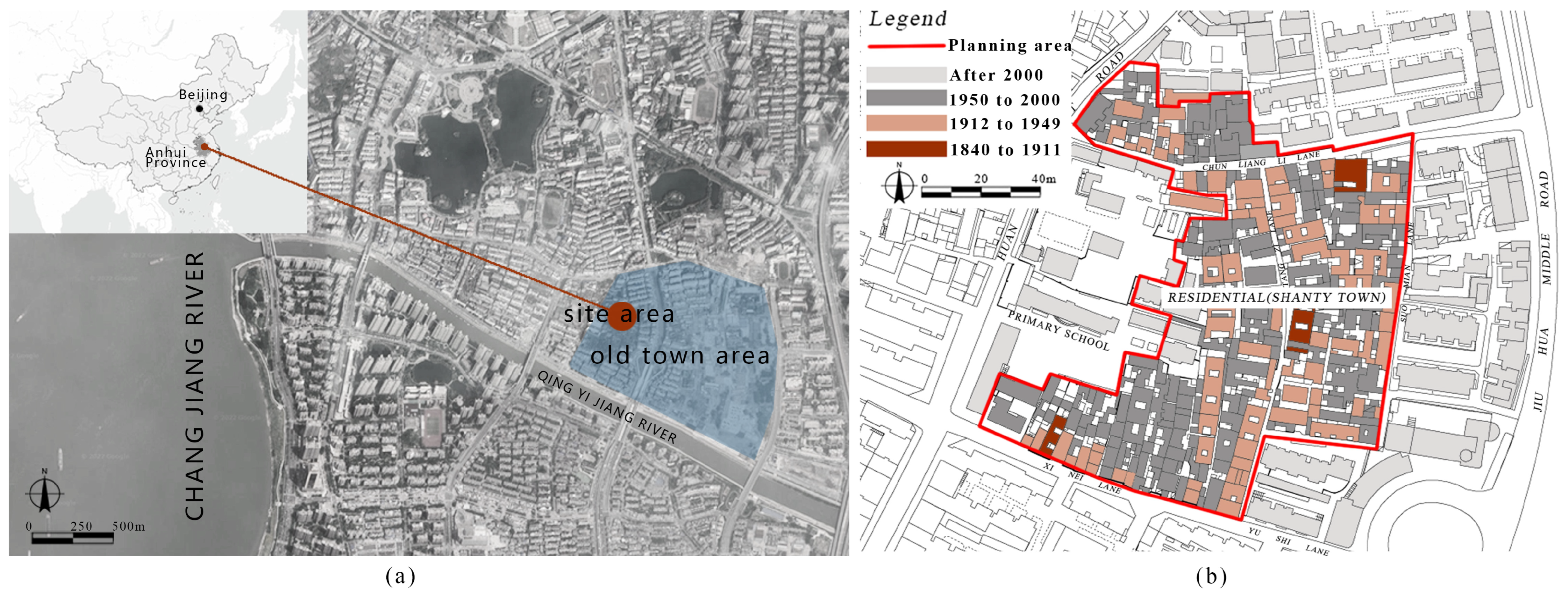
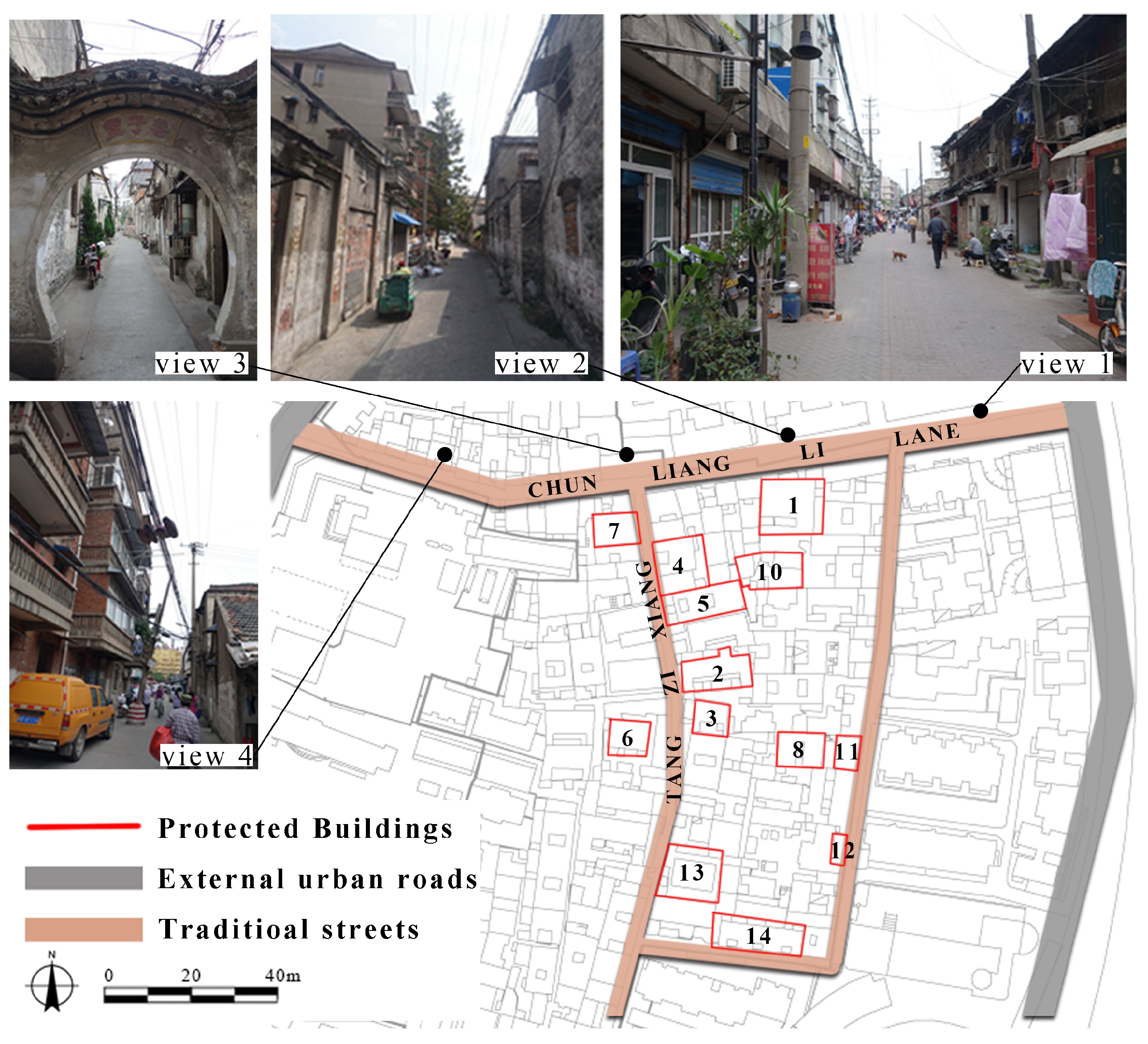
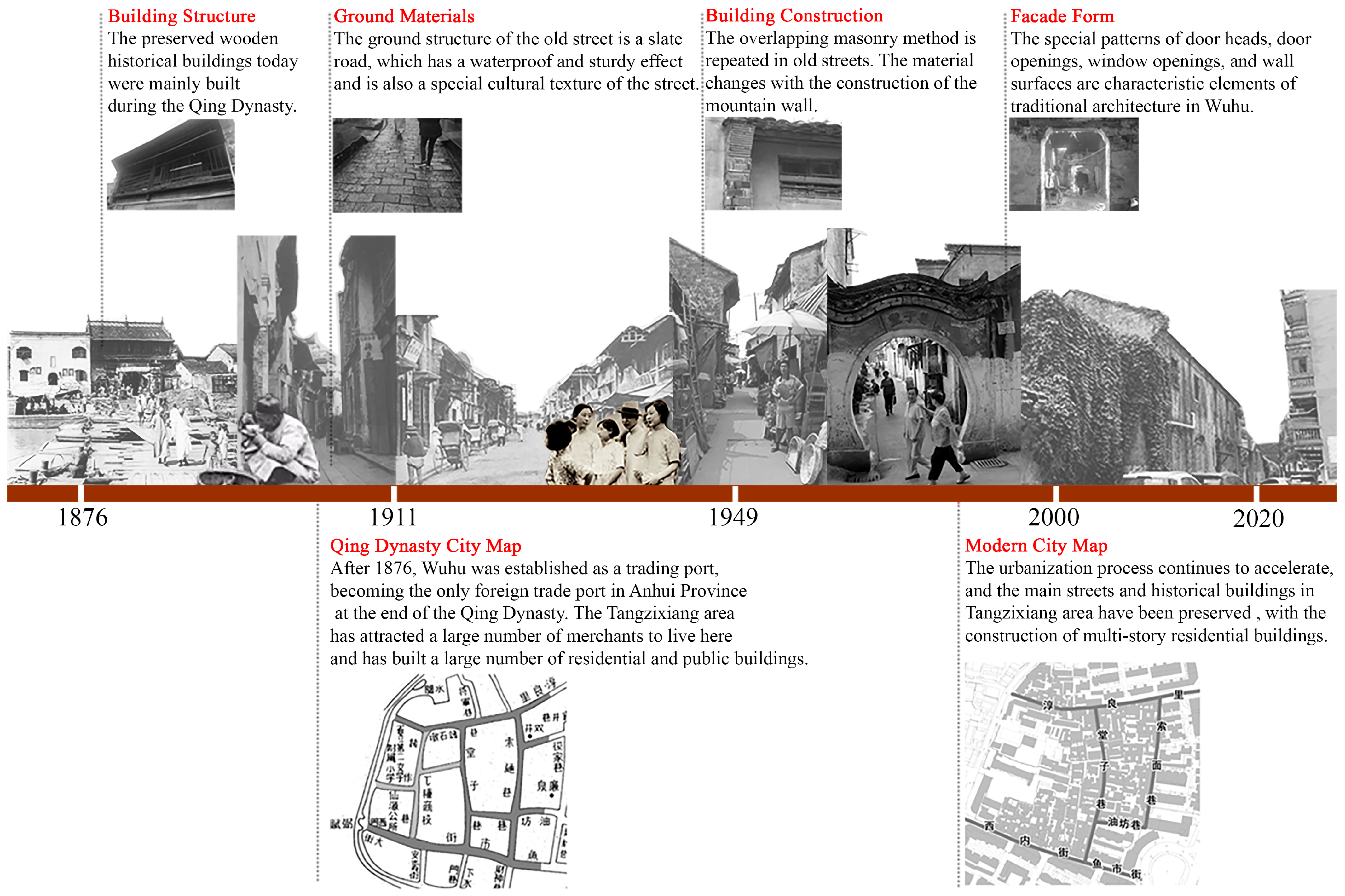
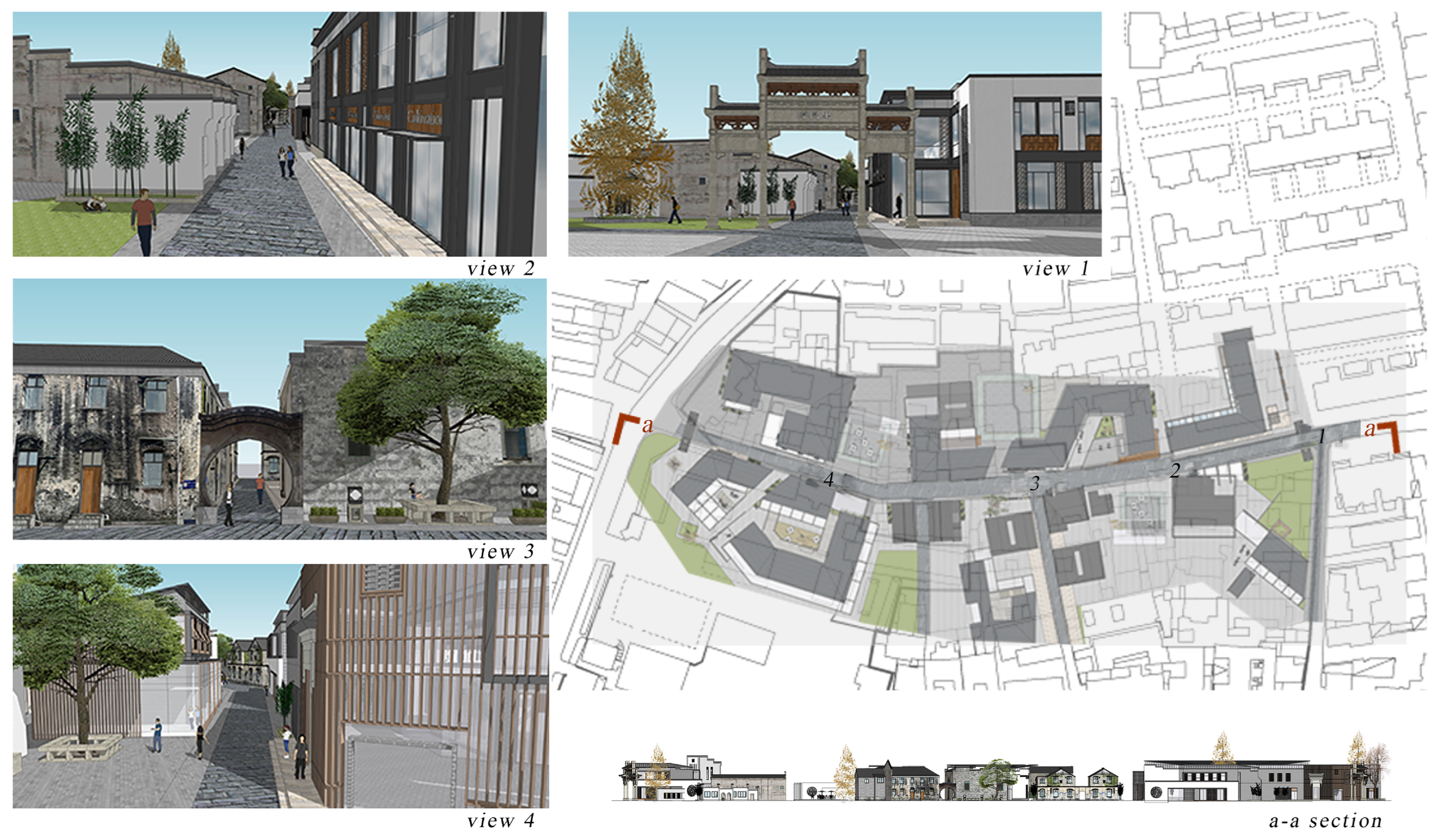
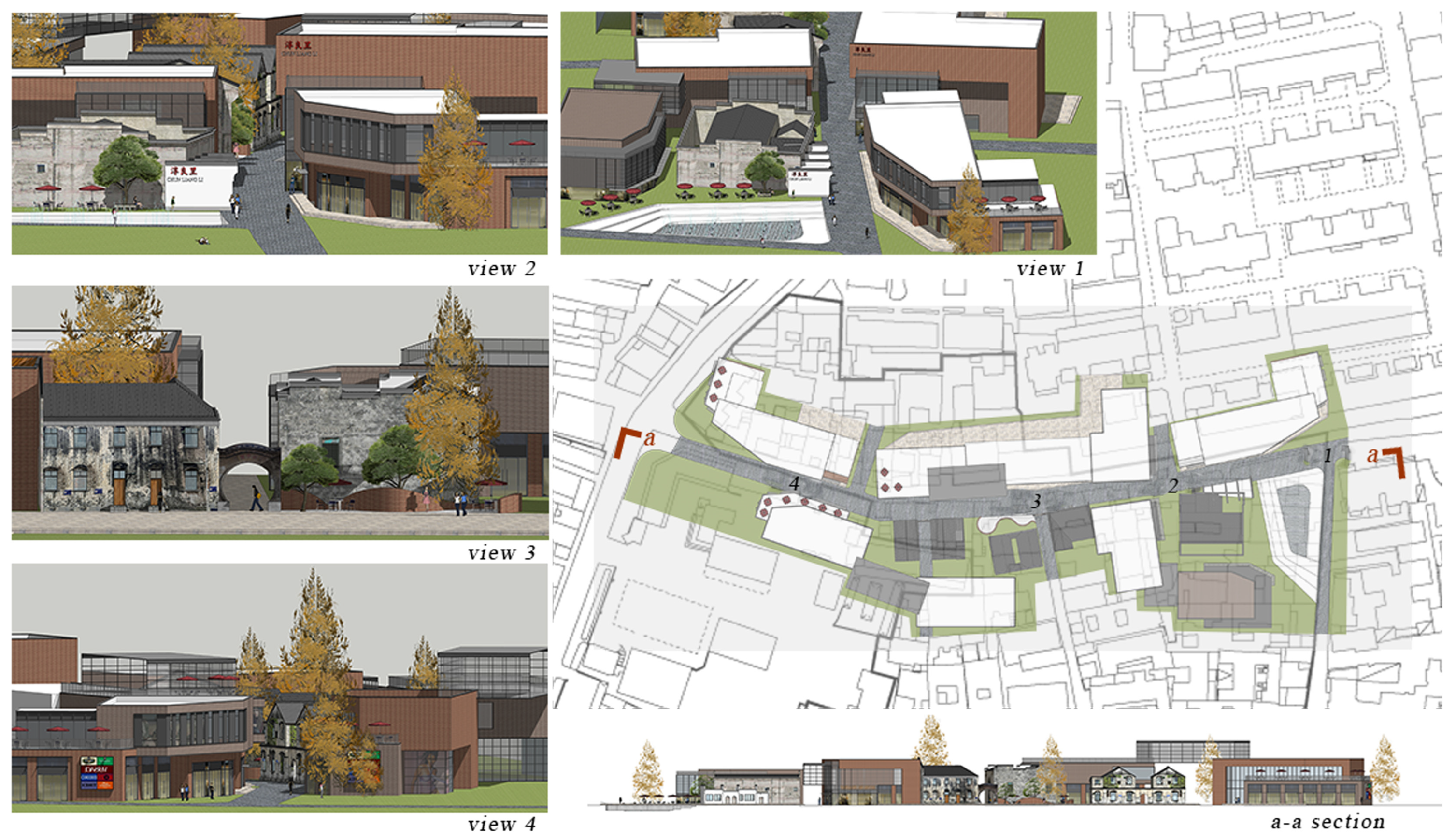
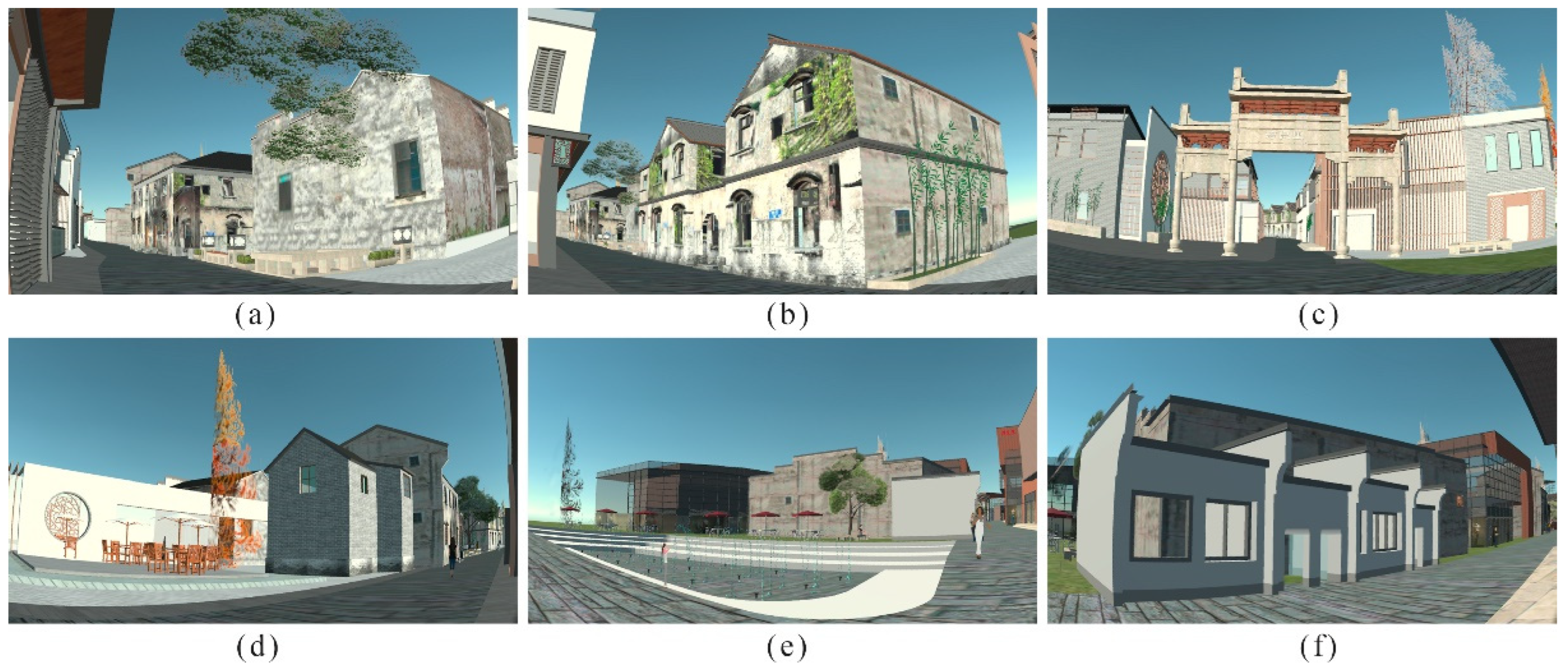


| Questions | No. | |
|---|---|---|
| Personal data: | ||
| Gender | Male/Female | |
| Age Group | <35/36–50/51–65/>65 | |
| Status of residence | Owner/Tenant | |
| Hukou type | Local/Nonlocal | |
| Duration of residence | <3/4–6/7–10/>10 | |
| Education | Lower than primary school/Elementary school/Secondary school/College or above | |
| VR experience: | ||
| Had you experienced VR before? | a1 | Yes/no |
| Which movement mode do you prefer? | a2 | Smooth movement/Node-based movement |
| I felt dizzy or sick. | a3 | 1–5 |
| VR scene is realistic. | a4 | 1–5 |
| I encourage the use of VR in renovation. | a5 | 1–5 |
| Engagement of inhabitants: | ||
| VR increases my engagement in renovation. | b1 | 1–5 |
| VR increases democratic decision-making in renovation. | b2 | 1–5 |
| VR improves self-initiated and self-organized renovation. | b3 | 1–5 |
| Local culture sustainability on Scheme 1: | ||
| The scheme avoids you losing the sense of place. | c1 | 1–5 |
| The scheme improves community interaction. | c2 | 1–5 |
| The scheme enhances city livability. | c3 | 1–5 |
| The scheme preserves the local culture. | c4 | 1–5 |
| Local culture sustainability on Scheme 2: | ||
| The scheme avoids you losing the sense of place. | d1 | 1–5 |
| The scheme improves community interaction. | d2 | 1–5 |
| The scheme enhances city livability. | d3 | 1–5 |
| The scheme preserves the local culture. | d4 | 1–5 |
| What else you wish to add? |
| Questions | No. | |
|---|---|---|
| Personal data: | ||
| Career | Design Institute/Real estate/government | |
| Service year | <3/4–6/7–10/>10 | |
| VR experience: | ||
| Had you experienced VR before? | e1 | Yes/no |
| VR scene is realistic. | e2 | 1–5 |
| I encourage the use of VR in scheme review. | e3 | 1–5 |
| How much paper materials can be saved by VR? | e4 | 0%/25%/50%/75%/100% |
| Questions | N | % |
|---|---|---|
| Age | ||
| <35 | 8 | 12.9 |
| 35–50 | 12 | 19.4 |
| 51–65 | 19 | 30.6 |
| >65 | 23 | 37.1 |
| Status of resident | ||
| Owner | 48 | 77.4 |
| Tenant | 14 | 22.6 |
| Hukou type | ||
| Local | 50 | 80.6 |
| Nonlocal | 12 | 19.4 |
| Duration of residence | ||
| 1–3 | 9 | 14.5 |
| 4–6 | 8 | 12.9 |
| 7–10 | 9 | 14.5 |
| >10 | 36 | 58.1 |
| Education | ||
| Lower than primary school | 9 | 14.5 |
| Elementary school | 16 | 25.8 |
| Secondary school | 25 | 40.3 |
| College or above | 12 | 19.4 |
| Mean | Std. Deviation | Sig. | |
|---|---|---|---|
| <35 | 15.9 | 3.4 | |
| 35–50 | 15.0 | 3.7 | |
| 51–65 | 14.5 | 2.8 | |
| >65 | 9.8 | 1.1 | |
| Total | 13.3 | 3.7 | |
| Between groups | 0.011 |
| Questions | N | % |
|---|---|---|
| Have you experienced VR before? | ||
| Yes | 19 | 30.6 |
| No | 43 | 69.4 |
| Which move mode do you prefer? | ||
| Smooth movement | 51 | 82.3 |
| Node-based movement | 11 | 17.7 |
| Mean | Std. Deviation | Sig. | |
|---|---|---|---|
| <35 | 2.1 | 0.7 | |
| 35–50 | 1.9 | 0.8 | |
| 51–65 | 2.3 | 0.8 | |
| >65 | 4.1 | 1.0 | |
| Total | 2.5 | 0.9 | |
| Between groups | 0.031 |
| Questions | Mean | Std. Deviation |
|---|---|---|
| VR scene is realistic. | 5.0 | 0.2 |
| I encourage the use of VR in renovation. | 4.6 | 0.3 |
| Questions | Mean | Std. Deviation |
|---|---|---|
| VR scene is realistic. | 4.2 | 0.7 |
| I encourage the use of VR in renovation. | 4.2 | 0.8 |
| Questions | Mean | Std. Deviation |
|---|---|---|
| VR increases my engagement in renovation. | 5.0 | 0.8 |
| VR increases democratic decision-making in renovation. | 2.6 | 0.9 |
| VR improves self-initiated and self-organized renovation. | 2.9 | 0.5 |
| Questions | Mean | Std. Deviation | t | Sig. |
|---|---|---|---|---|
| The scheme avoids you losing the sense of place. | −3.5 | 0.4 | −40.0 | <0.01 |
| The scheme improves community interaction. | −0.6 | 0.5 | −2.9 | 0.13 |
| The scheme enhances city livability. | 0.2 | 0.3 | 1.7 | 0.71 |
| The scheme preserves the local culture. | −3.1 | 0.4 | −40.0 | <0.01 |
| Impact Category | Unit | Total | Paper | Printing Ink | Electricity |
|---|---|---|---|---|---|
| Stratospheric ozone depletion | kg CFC11 eq | −1.01 × 103 | −8.70 × 102 | −1.35 × 102 | −2.84 |
| Ionizing radiation | kBq Co-60 eq | −1.05 × 108 | −1.06 × 108 | −1.37 × 106 | −1.01 × 104 |
| Ozone formation, Human health | kg NOx eq | −5.91 × 106 | −5.78 × 106 | −1.19 × 105 | −9.73 × 103 |
| Fine particulate matter formation | kg PM2.5 eq | −8.28 × 106 | −8.15 × 106 | −1.25 × 105 | −2.81 × 103 |
| Ozone formation, Terrestrial ecosystems | kg NOx eq | −6.01 × 106 | −5.87 × 106 | −1.26 × 105 | −1.02 × 104 |
| Terrestrial acidification | kg SO2 eq | −9.77 × 106 | −9.57 × 106 | −1.95 × 105 | −8.04 × 103 |
| Freshwater eutrophication | kg P eq | −2.66 × 106 | −2.71 × 106 | −4.55 × 104 | −2.23 × 102 |
| Marine eutrophication | kg N eq | −1.98 × 105 | −1.69 × 105 | −2.87 × 104 | −2.66 × 101 |
| Terrestrial ecotoxicity | kg 1,4-DCB | −6.27 × 109 | −6.05 × 109 | −2.11 × 108 | −3.87 × 106 |
| Freshwater ecotoxicity | kg 1,4-DCB | −9.32 × 107 | −9.19 × 107 | −1.32 × 106 | −3.52 × 104 |
| Marine ecotoxicity | kg 1,4-DCB | −1.26 × 108 | −1.24 × 108 | −1.81 × 106 | −4.90 × 104 |
| Human carcinogenic toxicity | kg 1,4-DCB | −1.29 × 108 | −1.26 × 108 | −3.28 × 106 | −8.02 × 103 |
| Human non-carcinogenic toxicity | kg 1,4-DCB | −3.70 × 109 | −3.66 × 109 | −4.42 × 107 | −9.19 × 105 |
| Land use | m2a crop eq | −1.42 × 109 | −1.40 × 109 | −1.46 × 107 | −5.22 × 104 |
| Mineral resource scarcity | kg Cu eq | −4.64 × 106 | −4.57 × 106 | −6.95 × 104 | −2.63 × 103 |
| Fossil resource scarcity | kg oil eq | −6.59 × 108 | −6.29 × 108 | −2.60 × 107 | −4.09 × 106 |
| Water consumption | m3 | −5.81 × 107 | −5.74 × 107 | −7.06 × 105 | −1.90 × 104 |
Disclaimer/Publisher’s Note: The statements, opinions and data contained in all publications are solely those of the individual author(s) and contributor(s) and not of MDPI and/or the editor(s). MDPI and/or the editor(s) disclaim responsibility for any injury to people or property resulting from any ideas, methods, instructions or products referred to in the content. |
© 2024 by the authors. Licensee MDPI, Basel, Switzerland. This article is an open access article distributed under the terms and conditions of the Creative Commons Attribution (CC BY) license (https://creativecommons.org/licenses/by/4.0/).
Share and Cite
Li, T.; Li, Q. Virtual Reality in Historic Urban District Renovation for Enhancing Social and Environmental Sustainability: A Case of Tangzixiang in Anhui. Sustainability 2024, 16, 2665. https://doi.org/10.3390/su16072665
Li T, Li Q. Virtual Reality in Historic Urban District Renovation for Enhancing Social and Environmental Sustainability: A Case of Tangzixiang in Anhui. Sustainability. 2024; 16(7):2665. https://doi.org/10.3390/su16072665
Chicago/Turabian StyleLi, Tingjun, and Qingxiang Li. 2024. "Virtual Reality in Historic Urban District Renovation for Enhancing Social and Environmental Sustainability: A Case of Tangzixiang in Anhui" Sustainability 16, no. 7: 2665. https://doi.org/10.3390/su16072665
APA StyleLi, T., & Li, Q. (2024). Virtual Reality in Historic Urban District Renovation for Enhancing Social and Environmental Sustainability: A Case of Tangzixiang in Anhui. Sustainability, 16(7), 2665. https://doi.org/10.3390/su16072665






